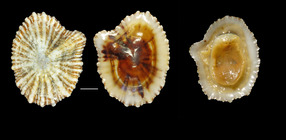MolluscaBase taxon details
Siphonaria crenata Blainville, 1827
181258 (urn:lsid:marinespecies.org:taxname:181258)
accepted
Species
Siphonaria rosea Hubendick, 1943 · unaccepted > junior subjective synonym
marine, brackish, fresh, terrestrial
recent only
Blainville, H. M. D. de. (1827). Siphonaire, <i>Siphonaria</i> (Malacoz.), pp. 291-296, in: Dictionnaire des Sciences Naturelles (F. Cuvier, ed.), vol. 49. Levrault, Strasbourg & Paris, & Le Normant, Paris. , available online at http://biodiversitylibrary.org/page/25314546
page(s): p. 295; note: based on Savigny (1817), pl. 3 fig. 3-35 [details]
page(s): p. 295; note: based on Savigny (1817), pl. 3 fig. 3-35 [details]
Note not stated [Red Sea coast of Egypt]
Type locality not stated [Red Sea coast of Egypt] [details]
MolluscaBase eds. (2025). MolluscaBase. Siphonaria crenata Blainville, 1827. Accessed at: https://www.molluscabase.org/aphia.php?p=taxdetails&id=181258 on 2025-09-11
![]() The webpage text is licensed under a Creative Commons
Attribution 4.0 License
The webpage text is licensed under a Creative Commons
Attribution 4.0 License
original description
Blainville, H. M. D. de. (1827). Siphonaire, <i>Siphonaria</i> (Malacoz.), pp. 291-296, in: Dictionnaire des Sciences Naturelles (F. Cuvier, ed.), vol. 49. Levrault, Strasbourg & Paris, & Le Normant, Paris. , available online at http://biodiversitylibrary.org/page/25314546
page(s): p. 295; note: based on Savigny (1817), pl. 3 fig. 3-35 [details]
original description (of Siphonaria rosea Hubendick, 1943) Hubendick, B. (1944). Beschreibung neuer Arten innerhalb der Gattung <i>Siphonaria</i>. <em>Arkiv för Zoologi.</em> 35A (1): 1-7.
page(s): 1, pl. 1, fig. 1 [details]
context source (Introduced species) Katsanevakis, S.; Bogucarskis, K.; Gatto, F.; Vandekerkhove, J.; Deriu, I.; Cardoso A.S. (2012). Building the European Alien Species Information Network (EASIN): a novel approach for the exploration of distributed alien species data. <em>BioInvasions Records.</em> 1: 235-245., available online at http://easin.jrc.ec.europa.eu [details] Available for editors [request]
[request]
basis of record Zenetos, A.; Gofas, S.; Russo, G.; Templado, J. (2004). CIESM Atlas of exotic species in the Mediterranean. Vol. 3 Molluscs, 376 pp. <em>Monaco, CIESM Publishers.</em> , available online at https://web.archive.org/web/20210507152030/http://www.ciesm.org/atlas/appendix3.html
page(s): 208-209 [details]
additional source Zenetos, A., S. Gofas, M. Verlaque, M. Cinar, J. Garcia Raso, C. Bianchi, C. Morri, E. Azzurro, M. Bilecenoglu, C. Froglia, I. Siokou, D. Violanti, A. Sfriso, G. San Martin, A. Giangrande, T. Katagan, E. Ballesteros, A. Ramos-Espla, F. Mastrototaro, O. Ocana, A. Zingone, M,. Gambi & N. Streftaris. (2010). Alien species in the Mediterranean Sea by 2010. A contribution to the application of European Union's Marine Strategy Framework Directive (MSFD). Part I. Spatial distribution. <em>Mediterranean Marine Science.</em> 11(2): 381-493., available online at https://doi.org/10.12681/mms.87 [details]
additional source Delongueville C. & Scaillet R. (2010). Importante population de <i>Siphonaria crenata</i> Blainville, 1827 implantée à l'ouest du golfe d'Iskenderun (Turquie). <em>Novapex.</em> 11(1): 8-11., available online at http://www.vliz.be/imisdocs/publications/253903.pdf [details]
additional source Jenkins, B.; Köhler, F. (2024). Hidden in plain sight: Systematic review of Indo-West Pacific Siphonariidae uncovers extensive cryptic diversity based on comparative morphology and mitochondrial phylogenetics (Mollusca, Gastropoda). <em>Megataxa.</em> 13(1): 1-217., available online at https://doi.org/10.11646/megataxa.13.1.1
page(s): 40 [details] Available for editors [request]
[request]
page(s): p. 295; note: based on Savigny (1817), pl. 3 fig. 3-35 [details]
original description (of Siphonaria rosea Hubendick, 1943) Hubendick, B. (1944). Beschreibung neuer Arten innerhalb der Gattung <i>Siphonaria</i>. <em>Arkiv för Zoologi.</em> 35A (1): 1-7.
page(s): 1, pl. 1, fig. 1 [details]
context source (Introduced species) Katsanevakis, S.; Bogucarskis, K.; Gatto, F.; Vandekerkhove, J.; Deriu, I.; Cardoso A.S. (2012). Building the European Alien Species Information Network (EASIN): a novel approach for the exploration of distributed alien species data. <em>BioInvasions Records.</em> 1: 235-245., available online at http://easin.jrc.ec.europa.eu [details] Available for editors
basis of record Zenetos, A.; Gofas, S.; Russo, G.; Templado, J. (2004). CIESM Atlas of exotic species in the Mediterranean. Vol. 3 Molluscs, 376 pp. <em>Monaco, CIESM Publishers.</em> , available online at https://web.archive.org/web/20210507152030/http://www.ciesm.org/atlas/appendix3.html
page(s): 208-209 [details]
additional source Zenetos, A., S. Gofas, M. Verlaque, M. Cinar, J. Garcia Raso, C. Bianchi, C. Morri, E. Azzurro, M. Bilecenoglu, C. Froglia, I. Siokou, D. Violanti, A. Sfriso, G. San Martin, A. Giangrande, T. Katagan, E. Ballesteros, A. Ramos-Espla, F. Mastrototaro, O. Ocana, A. Zingone, M,. Gambi & N. Streftaris. (2010). Alien species in the Mediterranean Sea by 2010. A contribution to the application of European Union's Marine Strategy Framework Directive (MSFD). Part I. Spatial distribution. <em>Mediterranean Marine Science.</em> 11(2): 381-493., available online at https://doi.org/10.12681/mms.87 [details]
additional source Delongueville C. & Scaillet R. (2010). Importante population de <i>Siphonaria crenata</i> Blainville, 1827 implantée à l'ouest du golfe d'Iskenderun (Turquie). <em>Novapex.</em> 11(1): 8-11., available online at http://www.vliz.be/imisdocs/publications/253903.pdf [details]
additional source Jenkins, B.; Köhler, F. (2024). Hidden in plain sight: Systematic review of Indo-West Pacific Siphonariidae uncovers extensive cryptic diversity based on comparative morphology and mitochondrial phylogenetics (Mollusca, Gastropoda). <em>Megataxa.</em> 13(1): 1-217., available online at https://doi.org/10.11646/megataxa.13.1.1
page(s): 40 [details] Available for editors
 Present
Present  Inaccurate
Inaccurate  Introduced: alien
Introduced: alien  Containing type locality
Containing type locality
From editor or global species database
Type locality not stated [Red Sea coast of Egypt] [details]From regional or thematic species database
Introduced species vector dispersal in Israeli part of the Mediterranean Sea - Eastern Basin (Marine Region) : Canals: natural range expansion through man-made canals [details]
To Malacopics (Siphonaria crenata Blainville, 1827 Egypt, Gulf of Aqaba, Dahab, beached, collected 1992-09-00, ex coll. J. Trausel .)
To Malacopics (Siphonaria crenata Blainville, 1827 Turkey, Hatay, Iskenderun Körfezi, on stones, at 2 m depth, collected August 2009, ex coll. J. Trausel)
To Malacopics (Siphonaria rosea Hubendick,1943 Saudi Arabia, Ash Sharqiyah, Dammam) (from synonym Siphonaria rosea Hubendick, 1943)
To Malacopics (Siphonaria crenata Blainville, 1827 Turkey, Hatay, Iskenderun Körfezi, on stones, at 2 m depth, collected August 2009, ex coll. J. Trausel)
To Malacopics (Siphonaria rosea Hubendick,1943 Saudi Arabia, Ash Sharqiyah, Dammam) (from synonym Siphonaria rosea Hubendick, 1943)
Unreviewed



.jpg)


